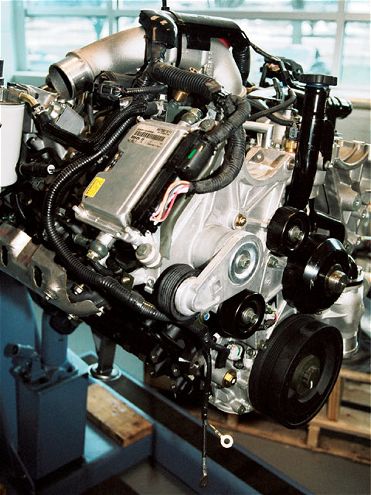
| duramax Diesel Electronics engine
Though not the first electrically controlled diesel in the light-duty market (the Ford 7.3L Power Stroke was), the General Motors 6.6L Duramax is recognized as one of the most sophisticated. It boasts four-valve aluminum cylinder heads, excellent component packaging, and a reputation for durability, power, fuel economy, low combustion noise, and very little vibration. Ironically, this high-tech engine exists due to the government-mandated emissions standards that required a 90-percent reduction in tailpipe discharge from previous mechanically fueled designs. Thus, gasoline-style engine management was required to tame and improve upon the diesel engine.
The Diesel Combustion ChallengeThere are three basic stages of diesel combustion that take place inside a direct-injection diesel engine-delay, uncontrolled combustion, and controlled combustion. These three stages are defined as follows:
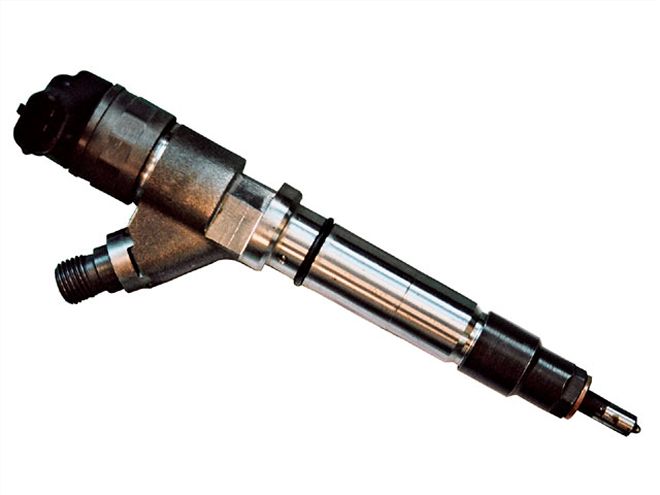
| The '06-and-newer injector quantity adjustment (IQA) injectors are flow-matched to the engine calibration software for variations at different duty-cycles. By doing this, the injectors are matched to the engine and the engine control module calibration.
Delay: Diesel fuel is sprayed into the compressed air charge in the cylinder and waits for the temperature to reach 1,000 degrees F to ignite.
Uncontrolled combustion: The injected diesel fuel then burns very rapidly in a rogue manner, much like detonation in a gasoline engine. This creates the diesel clatter.
Controlled combustion: The additional diesel fuel burns at the rate it is injected into the cylinder.
High-Tech Duramax SolutionTo achieve the desired emissions, noise, and vibration goals, the uncontrolled combustion stage needed to be minimized or eliminated. This could only be done through electronic control of the injector and an extremely high-pressure fuel source. In the case of the Duramax, GM uses a Bosch common-rail fuel system. The intent was to eliminate or at least minimize the central core of a mechanical injector spray pattern that would evoke the uncontrolled combustion event until a reaction zone (where the heat from the burned fuel travels into the unburned fuel) could be established.
Recognizing the need for the enthusiast to understand how electronic common-rail diesel engines operate, Diesel Power attended the General Motors Training Center in Ardsley, New York, to learn about the Duramax diesel engine. Special thanks to Training Center Manager Anthony Levens and Duramax instructor Don Post for making our hands-on education possible.
The Four Different Duramax EnginesThe Duramax 6600 has been produced in four different versions, and each version gets its name from its engine code. These engines are commonly known as the LB7, LLY, LBZ, and LMM. The engine models break down by the following codes, model years, and VIN numerals:
LB7- 2001 to 2004, VIN code 1
LLY- 2004.5 to 2006, VIN code 2
LBZ- 2006 to 2007, VIN code D
LMM- 2007.5-present, VIN code 6
Though there were evolutionary changes over the years to the engine and controls, most basic component functions stayed the same. The notable updates came when GM switched to the LLY engine in 2004 1/2 and added a variable geometry turbocharger, EGR, and altered the cylinder head and injector design. Then came the LBZ in 2006 and it featured a lower compression ratio, higher injection pressure, and an improved engine block design. The LMM version that arrived in 20071/2 added an electrically controlled throttle body that works in conjunction with the EGR and diesel particulate filter (DPF) to evoke the regeneration/cleaning process.
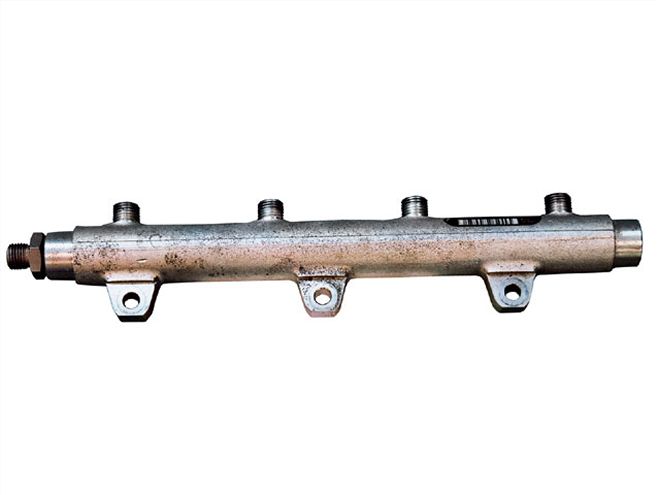
| The Duramax fuel rail system uses two separate fuel rails, one for each bank of the engine.
Control StrategyThe Duramax 6600 engine uses the following components to control the injection system. Input sensors monitor operating conditions of the engine and inputs from the driver. These inputs are sent to the engine control module (ECM), which processes sensor inputs and generates electrical output signals that get sent to the actuators that operate the engine.
Mass Air Flow (MAF) sensor: Mounted on the intake air assembly, it measures the volume of intake air for fuel delivery calculations.
Intake Air Temperature (IAT) sensor: Integral with the MAF sensor, it identifies intake air temperature for the ECM.
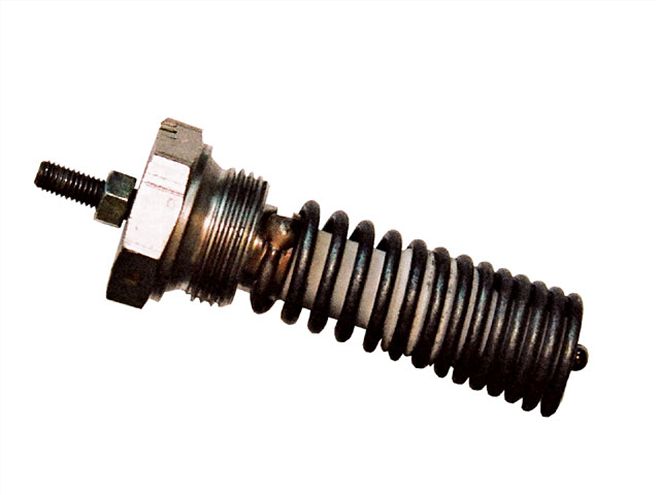
| The early intake air heater (IAH) is a coil that is placed in the air intake while later designs used a heated grid in the airflow path.
Intake Air Temperature #2 (IAT 2) sensor ('06-and-newer applications): Located in the intake manifold, this sensor is used to measure post-turbocharger intake air temperature.
Crankshaft Position (CKP) sensor: Mounted in the front engine cover, this identifies engine speed and generates a 57X signal to the ECM.
Camshaft position (CMP) sensor: Located at the front engine cover, this one provides a 3X signal to identify piston position.
Engine Coolant Temperature (ECT) sensor: Usually located on the top front of the engine, the ECT sensor identifies engine coolant values to the ECM.
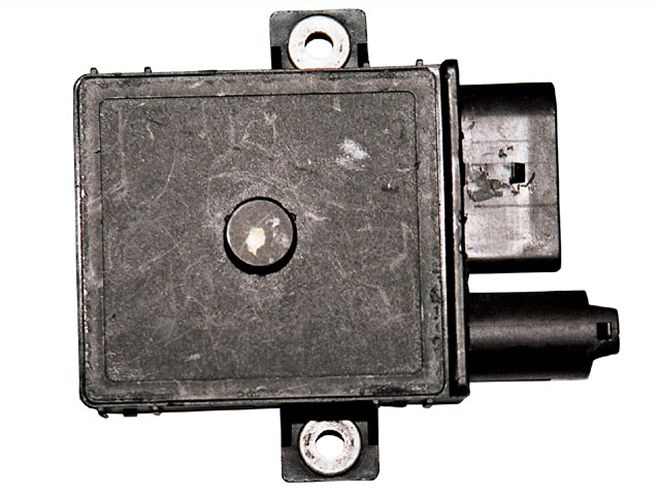
| As you can see, the glow plug controller is different on the Federal-emissions equipped trucks.
Barometric sensor ('01-'05 applications): Found on the left valve cover, it identifies barometric pressure for the ECM. The air pressure reading is used to fine-tune the fuel supply.
Boost Pressure (BP) sensor: Positioned within the intake manifold, the BP sensor measures absolute pressure and functions as a manifold absolute pressure (MAP) sensor.
Fuel Rail Pressure (FRP): This is an input to the ECM to fine-tune output from the high-pressure fuel pump via the fuel rail pressure regulator.
Fuel Temperature (FT) sensor: Located on the return line, it provides a signal to the ECM to fine-tune the fuel delivery.
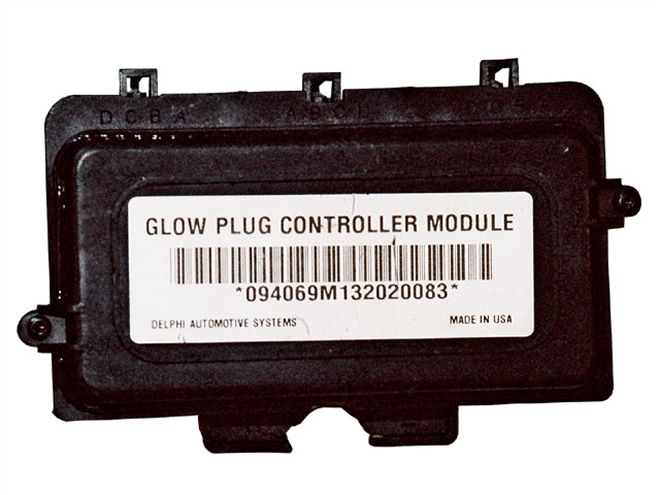
| As you can see, the glow plug controller is different on the Federal-emissions equipped trucks.
Low Oil Level Switch: Mounted in the oil pan, it identifies when the oil level is low.
Brake Switch: This instrument provides an input to the ECM used for fuel delivery and cruise control.
Transmission Range (TR) switch: The ECM uses the transmission gear selection sensors to enhance the idle quality.
Acceleration Pedal Position (APP) sensor: Made up of three individual sensors in one housing, it is mounted on the throttle pedal assembly. Each of the three sensors has a unique range of operation so that sufficient resolution is created for accurate throttle input.
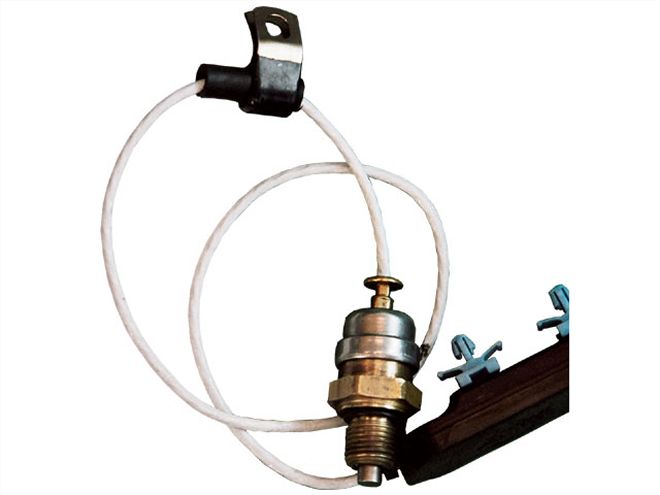
| This vane position sensor tells the ECM that the requested vane position has been achieved.
Vane Position Control Solenoid: Operated by the ECM, it controls the variable geometry function of the turbocharger. This is accomplished by altering the pressure and direction of engine oil acting on either side of a hydraulic piston. The piston has a rack of teeth that engage the pinion teeth of a cam. Piston movement causes the cam to rotate and pivot the vanes in the turbocharger. The ECM monitors this action with a vane position sensor.
Bosch Common-Rail InjectionThe Duramax engine employs a common-rail fuel system. Each bank of cylinders is supplied with fuel from its own rail, just as a multi-port gasoline engine would be.
The fuel injection pump, known as a CP3 pump, is located in the front of the engine "V" and is gear-driven from the camshaft and controlled electrically by the ECM through a fuel rail pressure regulator.
The injection pump has a fuel supply pump that is located at the rear of the unit, along with a high-pressure pump. There is no external lift pump on GM pickup trucks.
The supply pump moves fuel from the fuel tank to the inlet port of the high-pressure pump. The fuel pressure regulator varies the amount of fuel from the supply pump to the high-pressure pump in order to control the output pressure. The fuel injection pump generates a peak fuel pressure of approximately 26,000 psi. Typical pump pressure at idle is 5,000 to 6,000 psi.
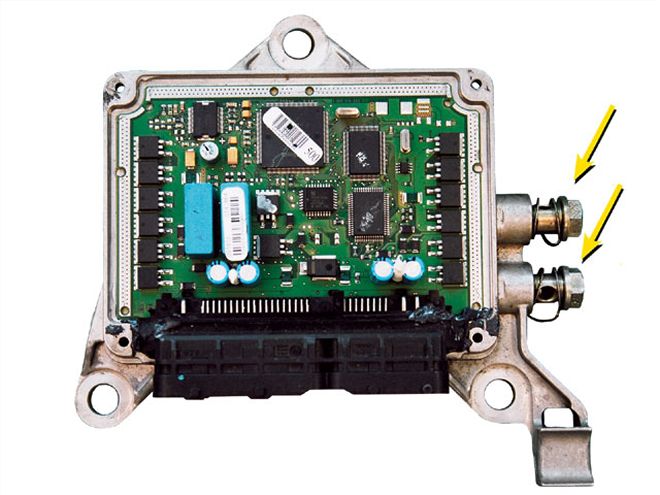
| The fuel injection control module (FICM) uses fuel (note banjo fittings on case) as a coolant. The FICM does the work of opening the common-rail injectors.
Fuel Injection Control Module (FICM)The timing of the fuel injection is controlled by the ECM through the fuel injection control module (FICM), which is a driver box (a driver is an electronic relay with no moving parts). The amount of fuel injected is determined by the fuel injector "On" time. Current flow to the injectors is controlled by the FICM. The ECM communicates with the FICM through a CAN (Controller Area Network) serial data link.
The engine uses two types of injection pulses for fuel delivery. Pilot injection is a small amount of fuel introduced to promote combustion efficiency and reduce combustion noise. A normal (main) injection immediately follows the pilot injection. Pilot injection strategy is not used at engine speeds above 2,500 rpm.
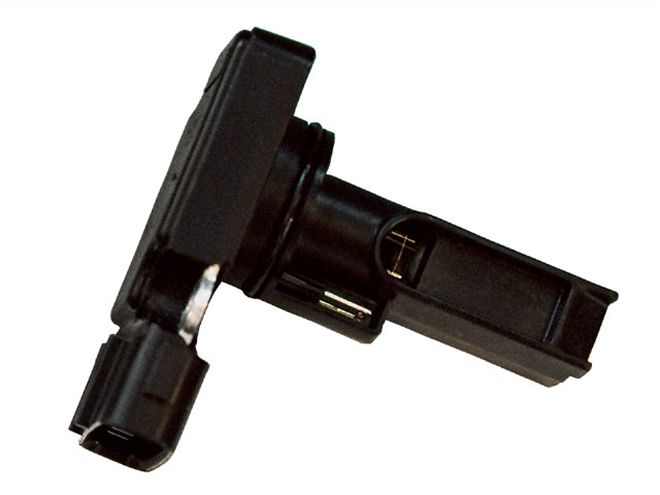
| The LB7 Duramax was the first light-duty diesel truck engine that used a mass airflow sensor (MAF) to measure the amount of air coming into the engine. It is located in the ducting that runs from the factory airbox to the turbocharger inlet.
The FICM is mounted on the passenger-side valve cover and is cooled with diesel fuel in order to reduce the heat produced by the electronic drivers. The electrical power required for fuel injector operation is 93 volts DC. As much as 20 amps of current is required to open a fuel injector, while 12 to 15 amps are needed to hold the injector open against fuel pressure.
The '04 1/2 LLY version had a number of changes. The FICM was a new design that allowed "top-to-bottom" fuel flow through the base of the unit for cooling purposes.
InjectorsThe fuel injectors used for '041/2 to '05 LLY Duramax engines had a six-hole spray pattern from the tip while the '06 version of the LLY employed a seven-hole design that also featured a double-guided and modified case that was 25 percent harder. The step bore improved installation with less chance of damaging the pintle.
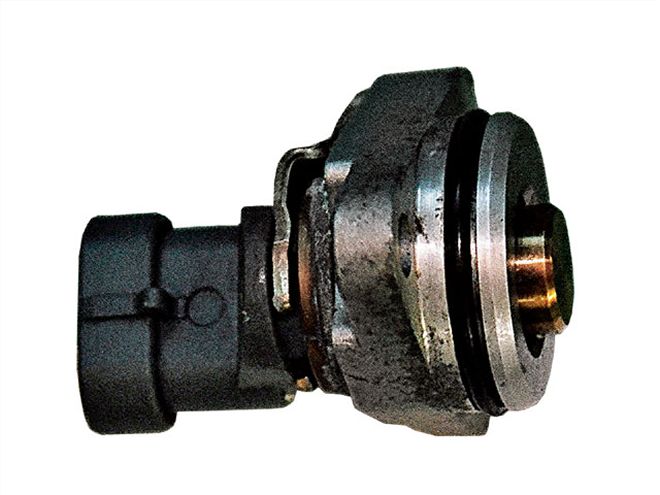
| The crankshaft position sensor is used to determine engine rpm. It's used in conjunction with the camshaft position sensor to determine which injectors to fire.
The later LLY, as well as newer versions of the Duramax, used a new injector identified as an IQA, or injector quantity adjustment. It is also referred to as injector flow rate programming (IFRP), and involves values assigned to each injector after flow testing at the production plant. During the manufacturing process, each injector is tested and its flow rate is measured at several duty cycles. These measurements are recorded as the injector flow rate value. This data is then recorded on the bar code label. It is laser etched as a hex number on the body of the injector before it is shipped to the Duramax engine plant in Moraine, Ohio.
The IQA values for each cylinder are written in the GPCM memory at the engine assembly plant. During final vehicle assembly (at another location), the values and cylinder position information from the GPCM are copied and written to the ECM memory.
The vehicle leaves the assembly plant with two identical copies of the stored IQA values, one in the GPCM and the other in the ECM.
The IQA values are used by the ECM to fine-tune the fuel delivery to each cylinder under all engine operating conditions.
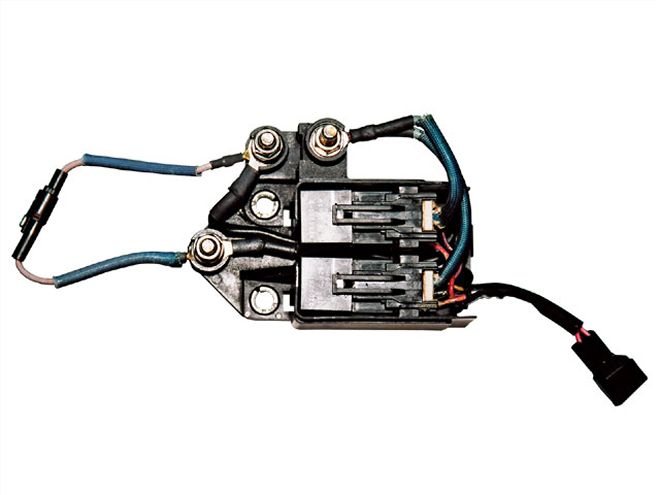
| The '01 to '03 Duramax used the ECM grounds to control the coil of the IAH. For Federal Emissions applications, the IAH relay was housed together with the glow plug relay. California emissions applications had the IAH relay separate from the glow plug relay.
Cold Weather Start-Up StrategyThe '01 to '03 and '06-and-later versions of the engine have the intake air heater (IAH) and glow plug relays located in one assembly. Both relays have a power feed from a 175-amp fuse that is hot at all times. The ECM controls each relay independently and uses self-diagnostics related to the control of each function that includes diagnostic trouble codes. Fusible links provide circuit protection.
Both the IAH and glow plugs use different control circuitry on vehicles sold in California. These applications use a glow plug controller.
Cold weather start-ups are achieved at temperatures as low as minus 20 degrees F by the use of glow plugs in the combustion chambers. The initial glow plug heating time varies based on the system voltage and temperature. A lower temperature requires longer heating times. The ECM provides glow plug operation after starting a cold engine, which helps reduce white exhaust smoke and improves idle quality after starting up.
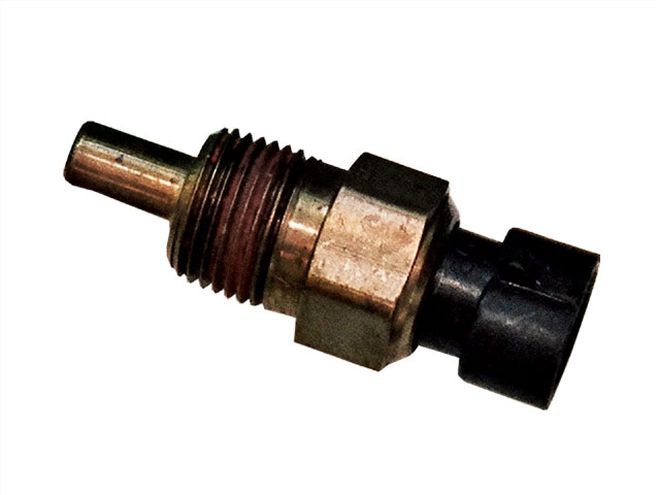
| The coolant temperature sensor is a critical component on any electronically controlled engine. The ECM references this sensor to adjust fueling curves, glow plug operation, and even the transmission torque converter clutch application.
The '01 to '03 engine used the intake air heater (IAH) to warm the air entering the engine for proper combustion. The ECM operates the IAH to also reduce white smoke during warm-up and after long deceleration. The '04 and '05 models did not use an IAH. The IAH system returned for '06 but with modifications. The '06 LLY applications use a grid-style IAH controlled by the glow plug control module.
The following command logic was common to most applications when the IAH was called for.
Coolant temperature 50 to 104 degrees FIAH commanded on 100% for 30 secondsIAH ramps down to 42% after 30 to 90 seconds of operationIAH will hold 42% for 90 to 500 secondsIAH will ramp to 0% after 500 to 600 seconds.
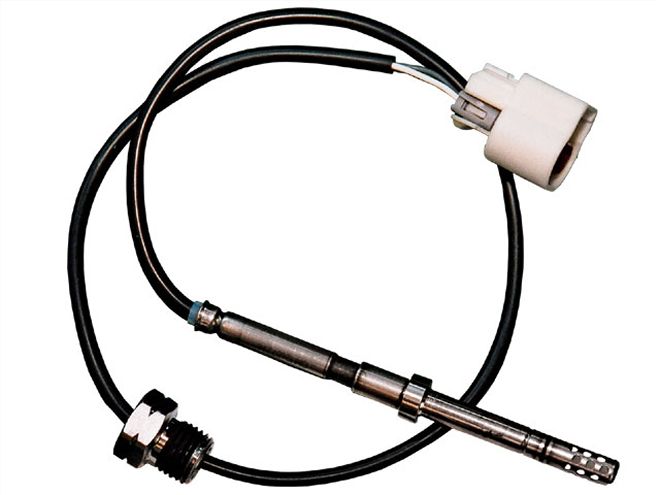
| In 2007, LMM Duramax-equipped trucks received an exhaust temperature sensor to monitor the diesel particulate filter (DPF).
Coolant temperature below 41 degrees FIAH commanded on 100% for 180 secondsIAH ramps down to 42% after 180 to 300 seconds of operationIAH will hold at 42% for 300 to 500 secondsIAH will ramp to 0% after 500 to 600 seconds
The LLY engine uses a glow plug system with a control module operated by the glow plug control module (GPCM). The GPCM connects to each of the eight glow plugs individually. This system uses silver-colored glow plugs that are marked LLY and are capable of providing 1,832-degree F heating within three seconds.
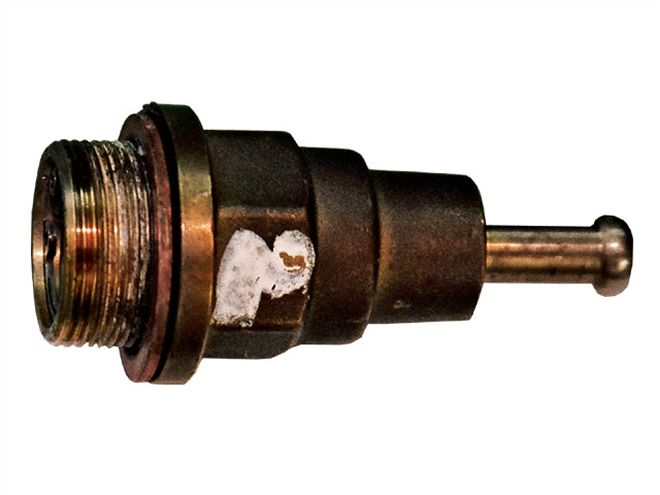
| Coolant flow to the variable geometry turbocharger housing is controlled by a dedicated thermostat.
Glow PlugsAll Duramax engines use one glow plug per cylinder. The gold-colored LB7 glow plugs are 12-volt heaters that are energized prior to starting the engine, and they may also be operated for a short time after the engine has started (up to 30 seconds). The LLY, LBZ, and LMM engines use silver-colored glow plugs and operate on 4.7 volts.
To meet 2001 California emissions, a solid-state glow plug controller operated by the ECM had dominion over heating each cylinder separately.
During typical glow plug operation, 110-amp current is applied for 1.8 seconds, decreasing to the 30 amps that are necessary to keep the tip at 1,832 degrees F.
The silver (LLY) and gold (LB7) glow plugs can't be interchanged. Use of the gold glow plugs in place of the silver will result in hard starting due to a lack of heat. Using the silver glow plugs in place of the gold will cause possible failure to the glow plugs, cylinder head, and internal engine damage.
 | duramax Diesel Electronics engine
Though not the first electrically controlled diesel in the light-duty market (the Ford 7.3L Power Stroke was), the General Motors 6.6L Duramax is recognized as one of the most sophisticated. It boasts four-valve aluminum cylinder heads, excellent component packaging, and a reputation for durability, power, fuel economy, low combustion noise, and very little vibration. Ironically, this high-tech engine exists due to the government-mandated emissions standards that required a 90-percent reduction in tailpipe discharge from previous mechanically fueled designs. Thus, gasoline-style engine management was required to tame and improve upon the diesel engine.
| duramax Diesel Electronics engine
Though not the first electrically controlled diesel in the light-duty market (the Ford 7.3L Power Stroke was), the General Motors 6.6L Duramax is recognized as one of the most sophisticated. It boasts four-valve aluminum cylinder heads, excellent component packaging, and a reputation for durability, power, fuel economy, low combustion noise, and very little vibration. Ironically, this high-tech engine exists due to the government-mandated emissions standards that required a 90-percent reduction in tailpipe discharge from previous mechanically fueled designs. Thus, gasoline-style engine management was required to tame and improve upon the diesel engine. | The '06-and-newer injector quantity adjustment (IQA) injectors are flow-matched to the engine calibration software for variations at different duty-cycles. By doing this, the injectors are matched to the engine and the engine control module calibration.
Delay: Diesel fuel is sprayed into the compressed air charge in the cylinder and waits for the temperature to reach 1,000 degrees F to ignite.
Uncontrolled combustion: The injected diesel fuel then burns very rapidly in a rogue manner, much like detonation in a gasoline engine. This creates the diesel clatter.
Controlled combustion: The additional diesel fuel burns at the rate it is injected into the cylinder.
High-Tech Duramax Solution
| The '06-and-newer injector quantity adjustment (IQA) injectors are flow-matched to the engine calibration software for variations at different duty-cycles. By doing this, the injectors are matched to the engine and the engine control module calibration.
Delay: Diesel fuel is sprayed into the compressed air charge in the cylinder and waits for the temperature to reach 1,000 degrees F to ignite.
Uncontrolled combustion: The injected diesel fuel then burns very rapidly in a rogue manner, much like detonation in a gasoline engine. This creates the diesel clatter.
Controlled combustion: The additional diesel fuel burns at the rate it is injected into the cylinder.
High-Tech Duramax Solution | The Duramax fuel rail system uses two separate fuel rails, one for each bank of the engine.
Control Strategy
| The Duramax fuel rail system uses two separate fuel rails, one for each bank of the engine.
Control Strategy | The early intake air heater (IAH) is a coil that is placed in the air intake while later designs used a heated grid in the airflow path.
Intake Air Temperature #2 (IAT 2) sensor ('06-and-newer applications): Located in the intake manifold, this sensor is used to measure post-turbocharger intake air temperature.
Crankshaft Position (CKP) sensor: Mounted in the front engine cover, this identifies engine speed and generates a 57X signal to the ECM.
Camshaft position (CMP) sensor: Located at the front engine cover, this one provides a 3X signal to identify piston position.
Engine Coolant Temperature (ECT) sensor: Usually located on the top front of the engine, the ECT sensor identifies engine coolant values to the ECM.
| The early intake air heater (IAH) is a coil that is placed in the air intake while later designs used a heated grid in the airflow path.
Intake Air Temperature #2 (IAT 2) sensor ('06-and-newer applications): Located in the intake manifold, this sensor is used to measure post-turbocharger intake air temperature.
Crankshaft Position (CKP) sensor: Mounted in the front engine cover, this identifies engine speed and generates a 57X signal to the ECM.
Camshaft position (CMP) sensor: Located at the front engine cover, this one provides a 3X signal to identify piston position.
Engine Coolant Temperature (ECT) sensor: Usually located on the top front of the engine, the ECT sensor identifies engine coolant values to the ECM.
 | As you can see, the glow plug controller is different on the Federal-emissions equipped trucks.
Barometric sensor ('01-'05 applications): Found on the left valve cover, it identifies barometric pressure for the ECM. The air pressure reading is used to fine-tune the fuel supply.
Boost Pressure (BP) sensor: Positioned within the intake manifold, the BP sensor measures absolute pressure and functions as a manifold absolute pressure (MAP) sensor.
Fuel Rail Pressure (FRP): This is an input to the ECM to fine-tune output from the high-pressure fuel pump via the fuel rail pressure regulator.
Fuel Temperature (FT) sensor: Located on the return line, it provides a signal to the ECM to fine-tune the fuel delivery.
| As you can see, the glow plug controller is different on the Federal-emissions equipped trucks.
Barometric sensor ('01-'05 applications): Found on the left valve cover, it identifies barometric pressure for the ECM. The air pressure reading is used to fine-tune the fuel supply.
Boost Pressure (BP) sensor: Positioned within the intake manifold, the BP sensor measures absolute pressure and functions as a manifold absolute pressure (MAP) sensor.
Fuel Rail Pressure (FRP): This is an input to the ECM to fine-tune output from the high-pressure fuel pump via the fuel rail pressure regulator.
Fuel Temperature (FT) sensor: Located on the return line, it provides a signal to the ECM to fine-tune the fuel delivery.
 | As you can see, the glow plug controller is different on the Federal-emissions equipped trucks.
Low Oil Level Switch: Mounted in the oil pan, it identifies when the oil level is low.
Brake Switch: This instrument provides an input to the ECM used for fuel delivery and cruise control.
Transmission Range (TR) switch: The ECM uses the transmission gear selection sensors to enhance the idle quality.
Acceleration Pedal Position (APP) sensor: Made up of three individual sensors in one housing, it is mounted on the throttle pedal assembly. Each of the three sensors has a unique range of operation so that sufficient resolution is created for accurate throttle input.
| As you can see, the glow plug controller is different on the Federal-emissions equipped trucks.
Low Oil Level Switch: Mounted in the oil pan, it identifies when the oil level is low.
Brake Switch: This instrument provides an input to the ECM used for fuel delivery and cruise control.
Transmission Range (TR) switch: The ECM uses the transmission gear selection sensors to enhance the idle quality.
Acceleration Pedal Position (APP) sensor: Made up of three individual sensors in one housing, it is mounted on the throttle pedal assembly. Each of the three sensors has a unique range of operation so that sufficient resolution is created for accurate throttle input.
 | This vane position sensor tells the ECM that the requested vane position has been achieved.
Vane Position Control Solenoid: Operated by the ECM, it controls the variable geometry function of the turbocharger. This is accomplished by altering the pressure and direction of engine oil acting on either side of a hydraulic piston. The piston has a rack of teeth that engage the pinion teeth of a cam. Piston movement causes the cam to rotate and pivot the vanes in the turbocharger. The ECM monitors this action with a vane position sensor.
Bosch Common-Rail Injection
| This vane position sensor tells the ECM that the requested vane position has been achieved.
Vane Position Control Solenoid: Operated by the ECM, it controls the variable geometry function of the turbocharger. This is accomplished by altering the pressure and direction of engine oil acting on either side of a hydraulic piston. The piston has a rack of teeth that engage the pinion teeth of a cam. Piston movement causes the cam to rotate and pivot the vanes in the turbocharger. The ECM monitors this action with a vane position sensor.
Bosch Common-Rail Injection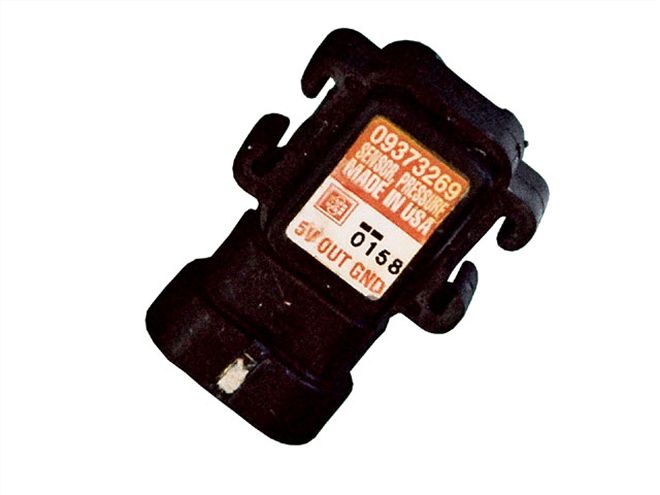

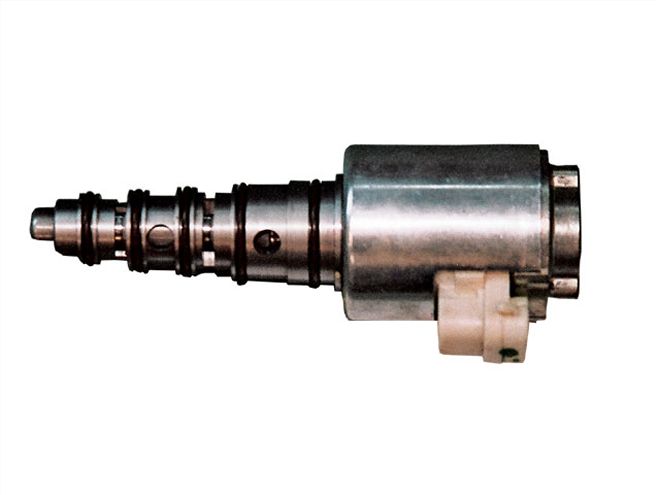
 | The fuel injection control module (FICM) uses fuel (note banjo fittings on case) as a coolant. The FICM does the work of opening the common-rail injectors.
Fuel Injection Control Module (FICM)
| The fuel injection control module (FICM) uses fuel (note banjo fittings on case) as a coolant. The FICM does the work of opening the common-rail injectors.
Fuel Injection Control Module (FICM) | The LB7 Duramax was the first light-duty diesel truck engine that used a mass airflow sensor (MAF) to measure the amount of air coming into the engine. It is located in the ducting that runs from the factory airbox to the turbocharger inlet.
The FICM is mounted on the passenger-side valve cover and is cooled with diesel fuel in order to reduce the heat produced by the electronic drivers. The electrical power required for fuel injector operation is 93 volts DC. As much as 20 amps of current is required to open a fuel injector, while 12 to 15 amps are needed to hold the injector open against fuel pressure.
The '04 1/2 LLY version had a number of changes. The FICM was a new design that allowed "top-to-bottom" fuel flow through the base of the unit for cooling purposes.
Injectors
| The LB7 Duramax was the first light-duty diesel truck engine that used a mass airflow sensor (MAF) to measure the amount of air coming into the engine. It is located in the ducting that runs from the factory airbox to the turbocharger inlet.
The FICM is mounted on the passenger-side valve cover and is cooled with diesel fuel in order to reduce the heat produced by the electronic drivers. The electrical power required for fuel injector operation is 93 volts DC. As much as 20 amps of current is required to open a fuel injector, while 12 to 15 amps are needed to hold the injector open against fuel pressure.
The '04 1/2 LLY version had a number of changes. The FICM was a new design that allowed "top-to-bottom" fuel flow through the base of the unit for cooling purposes.
Injectors | The crankshaft position sensor is used to determine engine rpm. It's used in conjunction with the camshaft position sensor to determine which injectors to fire.
The later LLY, as well as newer versions of the Duramax, used a new injector identified as an IQA, or injector quantity adjustment. It is also referred to as injector flow rate programming (IFRP), and involves values assigned to each injector after flow testing at the production plant. During the manufacturing process, each injector is tested and its flow rate is measured at several duty cycles. These measurements are recorded as the injector flow rate value. This data is then recorded on the bar code label. It is laser etched as a hex number on the body of the injector before it is shipped to the Duramax engine plant in Moraine, Ohio.
The IQA values for each cylinder are written in the GPCM memory at the engine assembly plant. During final vehicle assembly (at another location), the values and cylinder position information from the GPCM are copied and written to the ECM memory.
The vehicle leaves the assembly plant with two identical copies of the stored IQA values, one in the GPCM and the other in the ECM.
The IQA values are used by the ECM to fine-tune the fuel delivery to each cylinder under all engine operating conditions.
| The crankshaft position sensor is used to determine engine rpm. It's used in conjunction with the camshaft position sensor to determine which injectors to fire.
The later LLY, as well as newer versions of the Duramax, used a new injector identified as an IQA, or injector quantity adjustment. It is also referred to as injector flow rate programming (IFRP), and involves values assigned to each injector after flow testing at the production plant. During the manufacturing process, each injector is tested and its flow rate is measured at several duty cycles. These measurements are recorded as the injector flow rate value. This data is then recorded on the bar code label. It is laser etched as a hex number on the body of the injector before it is shipped to the Duramax engine plant in Moraine, Ohio.
The IQA values for each cylinder are written in the GPCM memory at the engine assembly plant. During final vehicle assembly (at another location), the values and cylinder position information from the GPCM are copied and written to the ECM memory.
The vehicle leaves the assembly plant with two identical copies of the stored IQA values, one in the GPCM and the other in the ECM.
The IQA values are used by the ECM to fine-tune the fuel delivery to each cylinder under all engine operating conditions.
 | The '01 to '03 Duramax used the ECM grounds to control the coil of the IAH. For Federal Emissions applications, the IAH relay was housed together with the glow plug relay. California emissions applications had the IAH relay separate from the glow plug relay.
Cold Weather Start-Up Strategy
| The '01 to '03 Duramax used the ECM grounds to control the coil of the IAH. For Federal Emissions applications, the IAH relay was housed together with the glow plug relay. California emissions applications had the IAH relay separate from the glow plug relay.
Cold Weather Start-Up Strategy | The coolant temperature sensor is a critical component on any electronically controlled engine. The ECM references this sensor to adjust fueling curves, glow plug operation, and even the transmission torque converter clutch application.
The '01 to '03 engine used the intake air heater (IAH) to warm the air entering the engine for proper combustion. The ECM operates the IAH to also reduce white smoke during warm-up and after long deceleration. The '04 and '05 models did not use an IAH. The IAH system returned for '06 but with modifications. The '06 LLY applications use a grid-style IAH controlled by the glow plug control module.
The following command logic was common to most applications when the IAH was called for.
Coolant temperature 50 to 104 degrees F
| The coolant temperature sensor is a critical component on any electronically controlled engine. The ECM references this sensor to adjust fueling curves, glow plug operation, and even the transmission torque converter clutch application.
The '01 to '03 engine used the intake air heater (IAH) to warm the air entering the engine for proper combustion. The ECM operates the IAH to also reduce white smoke during warm-up and after long deceleration. The '04 and '05 models did not use an IAH. The IAH system returned for '06 but with modifications. The '06 LLY applications use a grid-style IAH controlled by the glow plug control module.
The following command logic was common to most applications when the IAH was called for.
Coolant temperature 50 to 104 degrees F | In 2007, LMM Duramax-equipped trucks received an exhaust temperature sensor to monitor the diesel particulate filter (DPF).
Coolant temperature below 41 degrees F
| In 2007, LMM Duramax-equipped trucks received an exhaust temperature sensor to monitor the diesel particulate filter (DPF).
Coolant temperature below 41 degrees F | Coolant flow to the variable geometry turbocharger housing is controlled by a dedicated thermostat.
Glow PlugsAll Duramax engines use one glow plug per cylinder. The gold-colored LB7 glow plugs are 12-volt heaters that are energized prior to starting the engine, and they may also be operated for a short time after the engine has started (up to 30 seconds). The LLY, LBZ, and LMM engines use silver-colored glow plugs and operate on 4.7 volts.
To meet 2001 California emissions, a solid-state glow plug controller operated by the ECM had dominion over heating each cylinder separately.
During typical glow plug operation, 110-amp current is applied for 1.8 seconds, decreasing to the 30 amps that are necessary to keep the tip at 1,832 degrees F.
The silver (LLY) and gold (LB7) glow plugs can't be interchanged. Use of the gold glow plugs in place of the silver will result in hard starting due to a lack of heat. Using the silver glow plugs in place of the gold will cause possible failure to the glow plugs, cylinder head, and internal engine damage.
| Coolant flow to the variable geometry turbocharger housing is controlled by a dedicated thermostat.
Glow PlugsAll Duramax engines use one glow plug per cylinder. The gold-colored LB7 glow plugs are 12-volt heaters that are energized prior to starting the engine, and they may also be operated for a short time after the engine has started (up to 30 seconds). The LLY, LBZ, and LMM engines use silver-colored glow plugs and operate on 4.7 volts.
To meet 2001 California emissions, a solid-state glow plug controller operated by the ECM had dominion over heating each cylinder separately.
During typical glow plug operation, 110-amp current is applied for 1.8 seconds, decreasing to the 30 amps that are necessary to keep the tip at 1,832 degrees F.
The silver (LLY) and gold (LB7) glow plugs can't be interchanged. Use of the gold glow plugs in place of the silver will result in hard starting due to a lack of heat. Using the silver glow plugs in place of the gold will cause possible failure to the glow plugs, cylinder head, and internal engine damage.